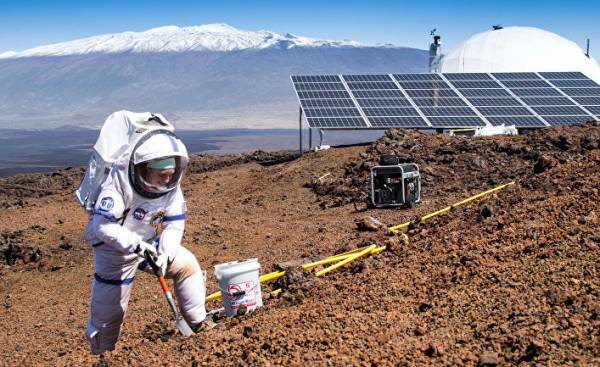
Translation carried out by the project Newочем
10 February 1853 the ship “Charles Mallory” came to the port of Honolulu, Hawaii. He came all the way from San Francisco in only 13 days — almost a record time, which was especially important achievement for a ship of such small size. “Charles Mallory” was one of the representatives of the newest model boats, the last word of navigation — a miracle of modern engineering and human ingenuity brought to the outside world one of the most isolated archipelagos. But every reason for celebration crossed the yellow flag waving on mast: the bringer of death, meaning that the Board had come to the Harbor “Charles Mallory” a raging smallpox.
Hawaii has never faced with this disease, and in spite of hasty quarantine attempts of vaccination, smallpox began its deadly March among the population. By early summer, the epidemic has spread in the whole body of o’ahu and rapidly spread to other Islands. In a desperate attempt to save Maui, a local doctor Dwight Baldwin inspired everyone who listened: “do Not let anyone to go ashore! Send them back! Ago! They will bring a terrible disease!” All summer and autumn, smallpox had decimated the population of the Islands. By that time, in January of 1854, the epidemic itself has ceased, the population of Oahu was halved, and on all Islands the inhabitants made up one fifth.
Fortunately, now smallpox in the past. A ship moored in Honolulu Harbor, has launched a series of technological revolutions that has persisted to this day. They reduce the distance between us, accelerate the pace of everyday life, unite our entire world. And for the most part, technological progress makes our life more safe: after all, life expectancy has doubled since 1850, and even since 1990, on average, around the world people are living six years longer. The development of vaccines and antimicrobials has practically put an end to child mortality in first world countries.
Eradicating smallpox, we are now on the verge of polio and dracunculiasis also in the past. With each new generation of engineers and give humanity a lighter, more durable and safer materials, providing thus the emergence of more reliable cars, planes and infrastructure. Built in 2008 to replace the collapsed in 2007, new road W35 bridge in Minneapolis is equipped with a 323 fiber-optic sensors. Due to this engineers can monitor the pressure on the bridge, the occurrence of corrosion and movement of the bridge.
In the technology, there is one positive side: we’re less eager to kill each other. With the help of international trade, the Internet and other international connections it brings us. We have less perceived each other as enemies. According to Steven Pinker in his book the Better Angels of Our Nature (2011):
“Due to the fact that technological progress offered the opportunity to exchange ideas and material goods over large distances and among larger groups, people become more valuable alive rather than dead. Instead of demonizing and dehumanizing others, we see in them potential partners for mutually beneficial cooperation”
It is difficult to disagree with the fact that over time people’s lives are constantly becoming safer and happier.
Even a quick glance at the technological improvements of the last decades is enough to have the impression that we are steadily moving along the line of progress, and former cares evaporate one after the other. Humanity as though even the “tamed” nature with its disasters, which we previously were so afraid of: very promising development in the field of tsunami early warning in a short time, may be able to prevent such a deadly disaster, like the earthquake and tsunami in the Indian ocean in 2004.
Technology have turned the natural world into something, in the words of Edmund Burke and Immanuel Kant, sublime. From the point of view of Kant, nature becomes sublime when it becomes a “power, not having power over us.” The disaster, observed from a safe position, brings the joyous, even transcendent experiences. The sublime comes from our awareness that we are independent by nature, have “the advantage over the forces of nature.” Sublime is when something dangerous is safe, the proof of the power of man and his ability to fend for themselves. Thus, each new generation of technological advances brings us more and more to the era of the Sublime.
Less obvious in this case, the hidden, sometimes shocking risks. As shows the case of “Charles Mallory”, sometimes in a latest technological research lurk in unexpected danger. Hawaii for centuries knew of smallpox just because of its remoteness from the rest of the world — from the Islands to San Francisco 4000 kilometers. They are far enough from civilization to any vehicle contaminated with the smallpox reached them by the time when the disease ceased. But “Charles Mallory” was so fast that he completed his journey before he managed to get rid of its deadly burden, and brought to the archipelago hitherto unseen killer.
The first of September 1859, British astronomer Richard Carrington observed coronal mass ejections, gusts of solar wind and magnetic energy coming from the solar corona. Subsequently named the Carrington Event, this phenomenon was not just the first was the release of the masses, but one of the biggest. It was preceded by a delicious light magnetic phenomena. In the Northern hemisphere, auroras could be seen even in San Salvador and Honolulu. As then wrote in the Baltimore Sun, “from sunset to 10 p.m. the whole sky was lit auroras, the most spectacular and glorious vision”.
At the time, this event caused minor damage to the Telegraph networks, but remember the most with its spectacular auroras in early September. However, if now there will be a solar flash the same strength as in the time of the Event Carrington (dvenadtsatiperstnoi there is the likelihood that this will happen before 2022), the impact of our advanced civilization may be completely different. If the ejection of coronal mass, the same power will hit the Earth, it will lead to catastrophic consequences.
National research Council of the USA has prepared a report in which it was estimated that to rebuild the infrastructure after the release, similar to the Carrington Event, it would take four to ten years, and, of course, billions of dollars. Particularly at risk are the huge transformers on which rests our whole energy system. A powerful stream of magnetic energy can easily lead to overload of the magnetic core of the transformer; it overheats, and its copper wires will melt. In the worst case scenario, if the Event Carrington again, this is so seriously destroy our infrastructure that will follow this terrible destruction of society, the threat is completely unknown for our “less civilized” ancestors.
Although the technology is put under human control events once a threat, there is the reverse side of the coin. It can be called a phenomenon, the opposite of the Sublime, revenge, of pent-up forces: the safe becomes dangerous. Perhaps we already understand that. Perhaps that is why our culture is awash with apocalyptic imagery, starting with “Godzilla” and ending with “day after tomorrow”, and we never lose interest in stories about our own arrogance, the most striking examples of how everyday life can turn into a disaster.
As if we remind ourselves that everything we create is fragile and at any moment might collapse. Or we thus try to see the real danger. Now we are free from the constant fear and trying to forget that once the danger was for us in the first place. Developing a vaccine, we to protect themselves from the fear of diseases that once tormented us, so that they come back. Lack of knowledge and paranoia led to the fact that in some Western countries people are actively began to refuse vaccination, what was the reason for the revival of viral diseases. In the US the death rate from whooping cough from 1 100 in 1965, declined to 6 in 1995, nevertheless, now there are new outbreaks in 2013 were recorded 48 000 cases of pertussis, which is greater than the figure for 1995: then ill was 5137. At the same time, lack of understanding of how to use antimicrobials and widespread misuse has led to the fact that there are new, resistant to modern medicines bacterium, is able to carry destruction among mankind in the next few decades.
Previously “curable” diseases like gonorrhea may soon again get out of control. As noted in 2013, the Director of the Center for disease control, Thomas Frieden: “the Most resistant microbes now emerging because of the fact that people have very little understanding of how to use the antibiotics.”
In the end, it’s been a long time since then, as amongst us there were people suffering from polio since then, as the whole settlement was wiped out smallpox. The longer we live, without having a clear idea about the threats, the less we perceive them as possible and the less seriously we take measures aimed to protect us from these threats. Writes Henry Petroski in his book about the failure of technology To Forgive Design (2012), despite considerable technological progress, buildings and bridges still crumbling, airplanes are falling, and machines fail — and not because of technology per se, but because of the inability of their creators to learn the lessons of the past, received such a high price.
“Unfortunately, the lessons learned from failures and mistakes, is too often forgotten as soon as together with technological progress failures getting smaller. This overshadows the fact that the process of creating now little has changed over the last thirty, three hundred and even three thousand years. In essence, the process of creativity does not have any temporary unesennoe. This means, among other things, that those erroneous judgments, which we carried three thousand, three hundred and thirty years ago, we learned today, they can also be expected in the future. Failure is part of science,” writes Petroski.
Despite all the progress, all our achievements, civilization does not necessarily have to evolve in the direction in which we would like. If technologies are developed for linear axes, this process is complemented by the cyclical nature of human failure, of forgetfulness and stupidity.
You can, of course, to say that the capacity of any technology is constrained by the capacity of the one who created it or uses it. Take, for example, the stock market: when the industrial index Dow Jones began to fail in 1929, there were those who at least tried to stop this process, including heads of the largest banks. 24 Oct 1929 they openly bought blocks of stock that gives high dividends, prices, many exceeding actual costs. This was done in order to instill confidence in the market. Ultimately it came to nothing lead, but slowed the collapse for five days, while people struggled in trying to end the crisis. But today even such remedies are inaccessible to us. When the market began to fall on may 6, 2010, imperfect algorithms led to the phenomenon known as “instant collapse,” during which industrial average the Dow Jones lost and then regained more than 600 points in a matter of minutes.
Analysts were almost unable to explain what happened. Basically, the fault lay in the computer programs designed to carry out sale for much higher speeds, not sensitive to human irrationality, vanity and stupidity, which may affect certain decisions. And yet these programs, working with the parameters set by their creators-people, created panic and ignorance in the decisions that they had to prevent, with the exception that at higher speed and with even a lesser degree of control. Without any intention we are putting our panic and short-sightedness in mechanisms to protect us from our worst impulses.
In the end, all around us, technology is bound to break for the simple reason that they were created by people. As Petroski writes, “all the inventions, especially those through which we interact, collapse, because they are the product of human effort, that is, they by their nature are inevitably imperfect, and often we understand this”.
Robots and autopilots can prevent human error, but they can’t balance the imperfections of their creators. Perhaps our bright technological future is not with the latest inventions in the world of gadgets, but that we will learn to better understand themselves, and in particular, our ability to forget lessons learned. Future technology doesn’t exist without the lessons of the past, it is a way to perpetuate our mistakes and lessons of these recommendations were made, as we steadily move forward.







